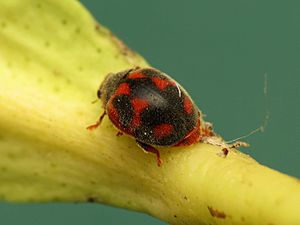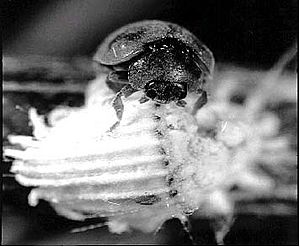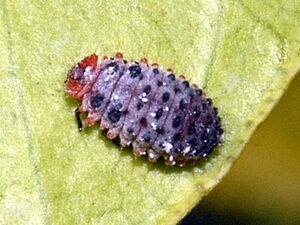Novius cardinalis facts for kids
Quick facts for kids Novius cardinalis |
|
|---|---|
 |
|
| Scientific classification | |
| Genus: |
Novius
|
| Species: |
cardinalis
|
| Synonyms | |
|
|
Novius cardinalis (also known as the vedalia beetle or cardinal ladybird) is a type of ladybug. It is thought to be originally from Australia. Until recently, it was called Rodolia cardinalis, but its name was changed in 2020.
Contents
What the Vedalia Beetle Looks Like
The adult vedalia beetle has a round body. It is about 2 to 4 millimeters long. Its body is covered with short, thick hairs. It is reddish-purple with black spots. These spots create a pattern across its body. The head, the back part of its chest (called the prothorax), and a small shield-shaped part (the scutellum) are all black.
Each wing cover (called an elytron) usually has five black spots. Four spots are on the top sides of the wing cover. The two spots near the front look like a half-moon. The two spots at the back have an irregular shape. The fifth spot runs along the middle seam of the wing cover, getting wider at the back.
The beetle's antennae are short and slightly wider at the end. They have 8 small parts. Its legs have a flat part that hides its foot (tarsus) when it rests. The foot has 3 small segments, just like all ladybugs.
The larva (baby beetle) is about 5 millimeters long. It can be reddish like the adult or grayish. It has black spots on its chest. The larva has small bumps on its side, each with short hairs. The pupa (the stage before becoming an adult) is 4 to 5 millimeters long. It is red, but it gets darker as it gets older.
What the Vedalia Beetle Eats

N. cardinalis often eats small insects like aphids and tiny mites. This makes them very helpful for controlling pests. They only eat things smaller than themselves. Most of their food is plant-eating insects. They do not hunt flying insects because they are not very good at flying.
They are especially good at eating a pest called the cottony cushion scale (Icerya purchasi).
How Vedalia Beetles Help Farmers
Vedalia beetles are used as a "biological control agent." This means they are natural enemies of pests. They help control harmful insects without using chemicals.
Vedalia Beetles in New Zealand
N. cardinalis was accidentally brought to New Zealand. They are not as common there now. In the late 1800s, a lot of cottony cushion scale insects appeared in California. These pests were harming citrus trees. So, some vedalia beetles were brought from New Zealand to California in 1888 to help.
Vedalia Beetles in Australia
There is a special seat in Palmer Gardens in North Adelaide, South Australia. It has a plaque that tells an important story. The plaque says that the vedalia ladybird beetle was collected there in 1888. It was used to successfully control the cottony cushion scale insect in California. This was a big success for biological pest control.
Vedalia Beetles in California
N. cardinalis beetles were brought to citrus farms in California in late 1888. They helped save the citrus industry from the cottony cushion scale pest.
Where Vedalia Beetles Live
Novius cardinalis can be found almost everywhere in the world, except Antarctica. They live in America (including the US, Central America, and South America). They are also found in Europe (like Spain, France, and Italy) and Asia (like Japan, India, and Siberia). You can find them in Africa (North and South Africa) and Oceania (like Hawaii and Guam). And, of course, they are found in their home region, Australia.
See also
 In Spanish: Rodolia cardinalis para niños
In Spanish: Rodolia cardinalis para niños


